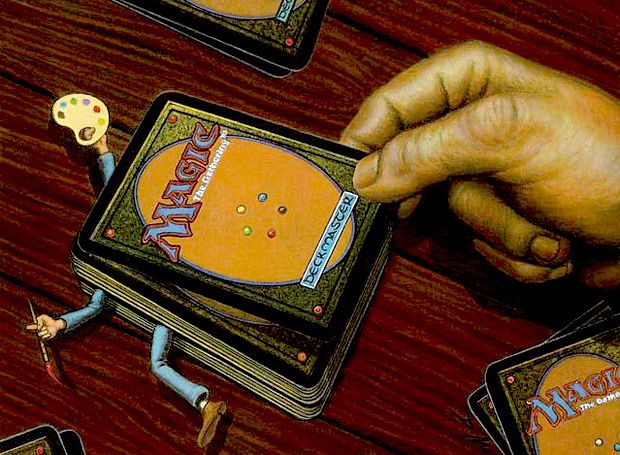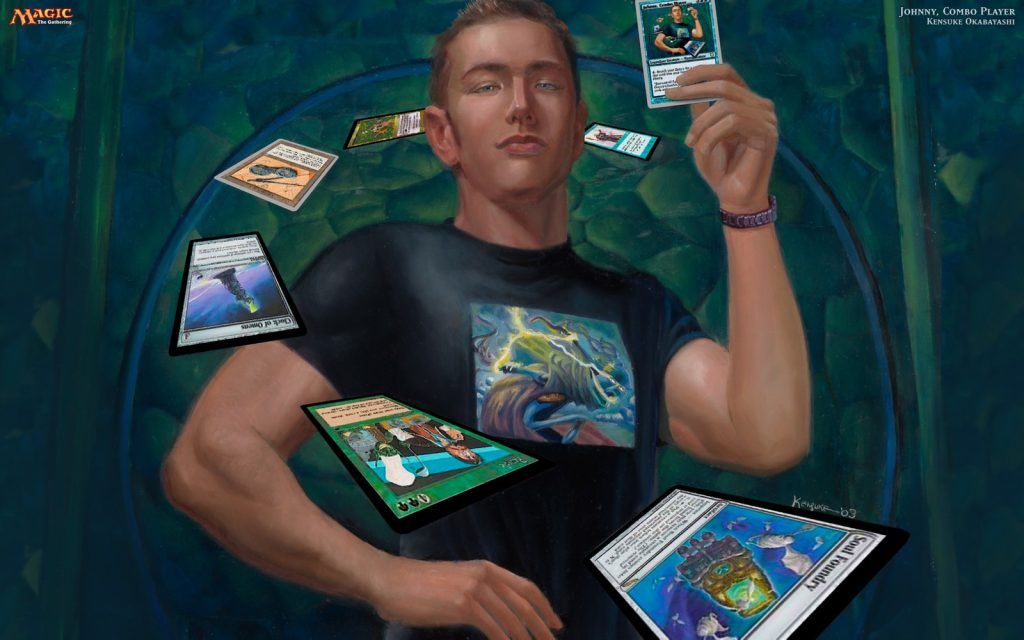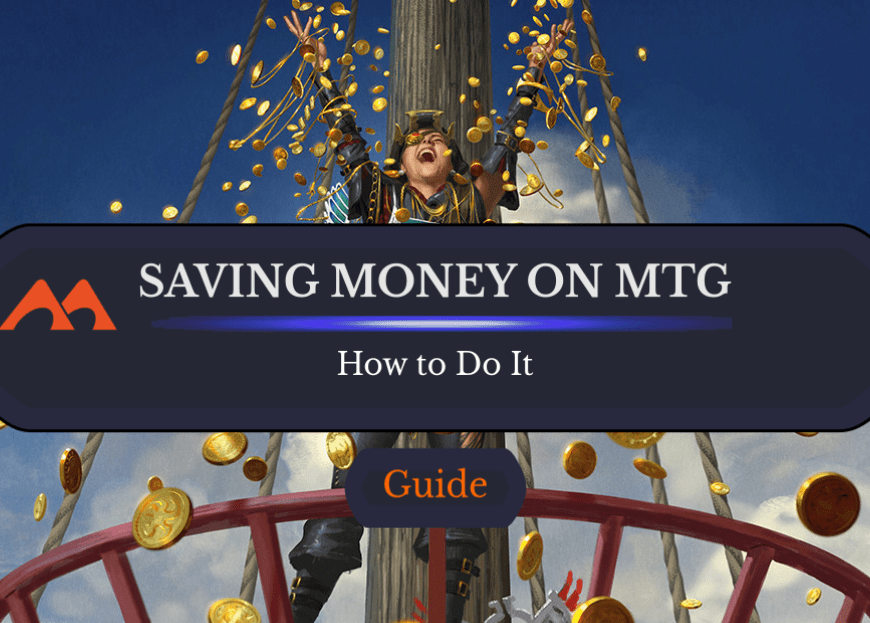
Negate | Illustration by Dominik Mayer
While players may put a lot of effort into thinking about mid- and late-game strategies, a critical part of Magic: The Gathering happens before the game even starts, as a hand with no lands or no playable spells is equivalent of already losing the game most of the time.
To bypass these situations, there are mulligan rules that you must know of, and today, we’ll explore how they’ve evolved over time and what makes each mulligan rule unique. We’ll also ultimately determine which is the best, or at least the most fun!
How Do Mulligans Work?

Aesthetic Consultation | Illustration by David Martin
In MTG, mulligans are a crucial aspect of gameplay and happen before the first turn of the game even starts. When a player takes a mulligan, they shuffle their hand back into their library and draw a new hand, returning one card to the bottom of their library for each mulligan they took. This process repeats until the player decides to keep their hand.
Although this rule currently stands, it's important to note that it has changed over time. Let's explore its history and look at each different mulligan rule that has occurred in MTG.
What is the Current Mulligan Rule?
The current mulligan rule in Magic: The Gathering is called the ‘London Mulligan.' This rule was tested during 2019’s Pro Tour London and has been in effect since the release of Core Set 2020. This is the rule described above, where players mulligan entire hands, draw new hands of seven cards, and put cards on the bottom of their library equal to the number of times they mulliganed.
The History of Mulligans in MTG
Magic: The Gathering didn't initially have a mulligan rule, mostly to discourage poor deckbuilding. But as the game evolved, formal rules emerged.
In 1994, the DCI introduced the Original Mulligan, which allowed players to reveal a hand with zero lands or spells, and shuffle it back to draw a new hand. Over time, the rules evolved, with the Vancouver Mulligan being widely embraced before the controversial introduction of the London Mulligan, which favored certain deck archetypes.
Before going through each particular rule in depth, let's discuss why you should pay more attention to mulligans and when it’s better to take them.
When to Mulligan in Competitive Play
Taking a mulligan has more benefits than just getting rid of ones with zero or all lands.
For example, in tournaments with open decklists, this is one of the most critical aspects of metagaming, as you can choose to mulligan into hands that can perform better against your opponent's deck, especially in game one.
On the other hand, you can also choose to mulligan towards better hands depending on the archetype you’re running.
Take aggro decks, for instance. They often want one or two lands and early drops to punish your opponents, so hands with three or four lands paired with high mana value creatures are often subject to mulligan.
An aggro deck should mulligan a hand like this:

And it’ll probably keep a hand like this:

For control decks, however, you want more lands and interaction spells, mostly removal or card advantage spells that can take over the tempo of the game. Something like this:

Of course, there are also combo decks that want to mulligan for combo pieces or specific cards.

Other reasons to mulligan include searching for a particular sideboard card that can shut down opponents' decks, or if you’re unlucky, drawing your combo piece that you want to cheat from your library in your initial hand.

How Mulligans Work on MTG Arena
MTG Arena follows the London Mulligan, with the normal decision to keep your hand or take a mulligan. After that, you return cards to the bottom of your library equal to the number of mulligans you took.
While this is true for most Arena modes, in Brawl and Historic Brawl, players have a free mulligan, meaning you don’t have to return a card the first time you take one.
When to Mulligan in Casual Play
Since casual play doesn’t follow conventional mulligan rules, there’s no fixed way to do it. Players may opt to use one of the above-mentioned mulligan rules, or custom ones that don’t include penalization, the latter being the most popular way among casual communities.
“Casual play” usually means Commander, which officially adopted the London Mulligan as its default mulligan option. If you’re playing kitchen-table Magic with friends at home, you can use whatever mulligan rules you’d like, but if you plan to attend your LGS for casual Commander night, you should expect to use the London Mulligan.
Some casual Commander groups allow unlimited mulligans up until a player finds a hand with three lands without hand-size penalization.
Different Ways to Mulligan
The Original Mulligan
Magic didn’t begin with a mulligan rule because the game developers didn't want to encourage poor deckbuilding. Later on, informal rules emerged to prevent unplayable hands.
Finally, in 1994, the DCI (Duelists' Convocation International) introduced the Original Mulligan, allowing players to reshuffle and draw a new hand if they had no lands or no non-lands, but only once per game. While this rule seemed fair, it became limiting as the game evolved, since it didn't account for the game's complexity beyond just lands and spells. Eventually, Magic adapted to create a more flexible mulligan rule to accommodate the game's dynamics.
Paris Mulligan
The “Paris Mulligan” allows players to reshuffle their starting hands, drawing one fewer card each time. This flexibility enabled players to shape their hands to their liking but came with a slight penalty for each mulligan taken. This rule persisted for much of Magic's history, from 1997 to 2015, and is often remembered fondly by many players. The mulligan's name originated from its debut at 1997’s Pro Tour Paris, despite being tested earlier at Pro Tour Los Angeles. Although unintentionally included in the game rules for Paris, the name stuck and became a significant part of Magic's history.
Vancouver Mulligan
The Vancouver Mulligan, introduced at Pro Tour Magic Origins in Vancouver, resembles the Paris Mulligan, allowing players to Scry 1 once they’ve kept a mulliganed hand. This adjustment aimed to streamline tournament play by encouraging players to keep their hands without excessive reshuffling. While I prefer the London Mulligan, I believe the Vancouver Mulligan rule was the most balanced one before the London Mulligan's introduction. The Magic community widely embraced it for its effectiveness and fairness.
London Mulligan
Lastly, The London Mulligan, introduced at 2019’s Mythic Championship London, sparked significant controversy due to its complete overhaul of the mulligan system. Despite the initial backlash, it has become the current standard mulligan rule, greatly enhancing the consistency of certain decks.
Under this rule, players draw seven cards each time and then place a number of cards equal to their mulligans taken on the bottom of their library after keeping a hand. I personally dislike this, as it favors combo archetypes especially (looking at you, Tron players).
Partial Paris
Partial Paris was the preferred mulligan method in Commander during its early inception. This allowed players to pick any number of individual cards from an opening hand of seven, shuffle them back into the library, and redraw that many cards without penalty. It allowed players to keep the best part of their opening hands while replacing the weaker parts. This has mostly been phased out except in certain social groups that prefer to use this method.
Mulligan in Pokemon
Other TCG’s also has their own mulligan rules. In Pokemon’s case, when opting for a mulligan, you must reveal your hand to your opponent if no basic Pokemon are in it, shuffle it into the deck, and draw seven new cards from the top. Continue this process until you acquire at least one basic pokemon card in your hand. For each mulligan you take, your opponent has the option to draw an additional card.
Mulligan in Hearthstone
Each player is dealt a random selection of cards during the mulligan stage in Hearthstone. The player going first gets three cards, while the player going second gets four. Both players have 65 seconds to choose which cards to replace with new ones from their deck (that's to say, they redraw individual cards, not the whole hand). It's important to note that the cards marked for replacement are not added back into the pool for possible replacements.
Mulligan in Yu-Gi-Oh
Come on; you have to believe in the heart of the cards in this game. Therefore, there's no mulligan in Yu-Gi-Oh.
How Many Mulligans Are Allowed in MTG
You can mulligan until you’re left with zero cards in hand at the beginning of the game. After that, players may not take any following mulligans. That means with a starting hand size of seven you can mulligan up to seven times (no, Backup Plans and Serum Powder don’t count).
While this isn’t very frequent if you’ve been playing the game for a while, you’ll face times when a mulligan down to two cards occurs, so don’t feel bad about it. It happens to all of us at some point.
Do You Shuffle Before You Mulligan?
If a player announces that they’re taking a mulligan, they shuffle their hand back first. Then, they draw a new set of cards and keep them according to the mulligan rule in use.
Is The First Mulligan in Commander Free?
The first mulligan in Commander is free, after which players follow the London Mulligan as normal. That means a player can shuffle a hand of seven cards into their library and draw a new hand of seven once without penalty. This rule also applies in Two-Headed Giant. Each individual player on a team can mulligan without penalty once.
What is a Good Amount of Time to Decide on Keeping or Mulliganing a Hand?
While taking a minute or two to decide if a mulligan is perferred, you don’t want to take excessive time on it, regardless of the format you’re playing. Doing so may incur a slow-play penalty from the judge who’s looking over the tournament or game if they determine youre spending too much time on a mulligan decision.
Even in casual formats you should make mulligan decisions in a timely manner. After all, players are there to play games, not stare at you for hours without playing.
Wrap Up

Johnny, Combo Player | Illustration by Kensuke Okabayashi
Ultimately, are mulligans good for Magic: The Gathering or not? The answer is yes. Otherwise, some games would end before they started, with players not having access to vital resources like lands, or even losing against tough matchups because they couldn’t dig for crucial sideboard cards. While the current mulligan rules have their flaws, they’re widely accepted by the most popular influencers of the game. However, I won’t discount the possibility that in the future, we may look at another mulligan rule aiming to improve on the current one.
What do you think? Is the current rule good enough? Or would you like to see other ones like the Hearthstone one implemented? Let us know in the comments or on Discord!
As always, thanks for reading up until now, and to never miss an article consider following us on Twitter/X. Take care, and we will meet again in my next article!
Follow Draftsim for awesome articles and set updates:

Add Comment